
Francisco José de Goya y Lucientes was a Spanish romantic painter and printmaker. He is considered the most important Spanish artist of the late 18th and early 19th centuries. His paintings, drawings, and engravings reflected contemporary historical upheavals and influenced important 19th- and 20th-century painters. Goya is often referred to as the last of the Old Masters and the first of the moderns.

Charles IV was King of Spain and ruler of the Spanish Empire from 1788 to 1808.

The Naked Maja or The Nude Maja is an oil on canvas painting made around 1797–1800 by the Spanish artist Francisco de Goya, and is now in the Museo del Prado in Madrid. It portrays a nude woman reclining on a bed of pillows, and was probably commissioned by Manuel de Godoy, to hang in his private collection in a separate cabinet reserved for nude paintings. Goya created a pendant of the same woman identically posed, but clothed, known today as La maja vestida, also in the Prado, and usually hung next to La maja desnuda. The subject is identified as a maja or fashionable lower-class Madrid woman, based on her costume in La maja vestida.

The Countess of Chinchon was painted by Francisco Goya about 1800. It is held in the Museo del Prado, Madrid. The painting depicts María Teresa de Borbón, 15th Countess of Chinchón, who had been encouraged by Queen Maria Luisa of Parma and by opportunism to marry Manuel de Godoy, the Prime Minister, in a marriage of convenience. It does not depict the more famous Countess of Chinchón who became the namesake of the cinchona genus of trees and shrubs responsible for early modern quinine production.

The Third of May 1808 is a painting completed in 1814 by the Spanish painter Francisco Goya, now in the Museo del Prado, Madrid. In the work, Goya sought to commemorate Spanish resistance to Napoleon's armies during the occupation of 1808 in the Peninsular War. Along with its companion piece of the same size, The Second of May 1808, it was commissioned by the provisional government of Spain at Goya's suggestion.
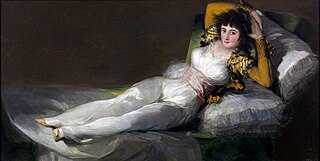
La maja vestida is an oil painting on canvas created between 1800 and 1807 by the Spanish Romantic painter and printmaker Francisco Goya. It is a clothed version of the earlier La maja desnuda, which was created between 1795 and 1800. The identity of the model and that of the commissioner have not been confirmed. However, art historians and scholars have suggested she is María Cayetana de Silva or Godoy's mistress Pepita Tudó. The Clothed Maja was created during the peak of Romanticism.

Saturn Devouring His Son is a painting by Spanish artist Francisco Goya. It is traditionally interpreted as a depiction of the Greek myth of the Titan Cronus eating one of his offspring. Fearing a prophecy foretold by Gaea that predicted he would be overthrown by one of his children, Saturn ate each one upon their birth. The work is one of the 14 so-called Black Paintings that Goya painted directly on the walls of his house sometime between 1819 and 1823. It was transferred to canvas after Goya's death and is now in the Museo del Prado in Madrid.
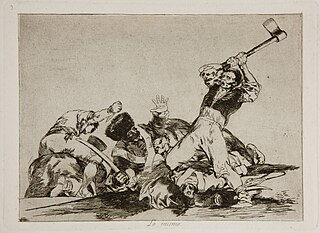
The Disasters of War is a series of 82 prints created between 1810 and 1820 by the Spanish painter and printmaker Francisco Goya (1746–1828). Although Goya did not make known his intention when creating the plates, art historians view them as a visual protest against the violence of the 1808 Dos de Mayo Uprising, the subsequent Peninsular War of 1808–1814 and the setbacks to the liberal cause following the restoration of the Bourbon monarchy in 1814. During the conflicts between Napoleon's French Empire and Spain, Goya retained his position as first court painter to the Spanish crown and continued to produce portraits of the Spanish and French rulers. Although deeply affected by the war, he kept private his thoughts on the art he produced in response to the conflict and its aftermath.

The Sleep of Reason Produces Monsters or The Dream of Reason Produces Monsters is an aquatint by the Spanish painter and printmaker Francisco Goya. Created between 1797 and 1799 for the Diario de Madrid, it is the 43rd of the 80 aquatints making up the satirical Los caprichos.

The Colossus, is known in Spanish as El Coloso and also El Gigante, El Pánico and La Tormenta. It is a painting traditionally attributed to Francisco de Goya that shows a giant in the centre of the canvas walking towards the left hand side of the picture. Mountains obscure his legs up to his thighs and clouds surround his body; the giant appears to be adopting an aggressive posture as he is holding one of his fists up at shoulder height. A dark valley containing a crowd of people and herds of cattle fleeing in all directions occupies the lower third of the painting.
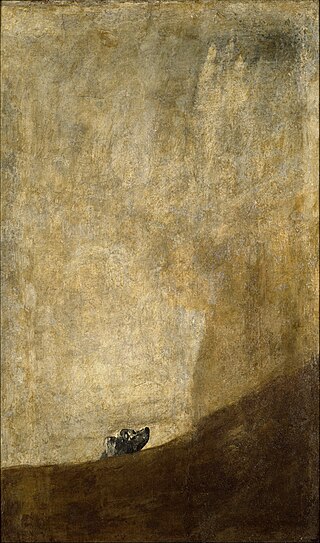
The Dog is the name usually given to a painting by Spanish artist Francisco Goya, now in the Museo del Prado, Madrid. It shows the head of a dog gazing upwards. The dog itself is almost lost in the vastness of the rest of the image, which is empty except for a dark sloping area near the bottom of the picture: an unidentifiable mass which conceals the animal's body. The placard for The Dog painting in The Prado indicates the dog is in distress, quite literally, drowning.
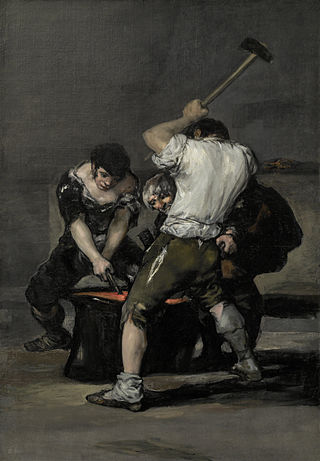
The Forge is a c. 1817 painting by Francisco Goya (1746–1828), today housed in the Frick Collection in New York City. The large oil on canvas represents three blacksmiths toiling over an anvil, and has been described by the art historian Fred Licht as "undoubtedly the most complete statement of Goya's late style."

Fight with Cudgels, called The Strangers or Cowherds in the inventories, is the name given to a painting by Spanish artist Francisco Goya, now in the Museo del Prado, Madrid. One of the series of Black Paintings Goya painted directly onto the walls of his house sometime between 1820 and 1823, it depicts two men fighting one another with cudgels, as they seem to be trapped knee-deep in a quagmire of mud or sand.

La Leocadia or The Seductress are names given to a mural by the Spanish artist Francisco Goya, completed sometime between 1819–1823, as one of his series of 14 Black Paintings. It shows a woman commonly identified as Goya's maid, companion and lover, Leocadia Weiss. She is dressed in a dark, almost funeral maja dress, and leans against what is either a mantelpiece or burial mound, as she looks outward at the viewer with a sorrowful expression. Leocadia is one of the final of the Black Paintings, which he painted in his seventies at a time when he was consumed by political, physical and psychological turmoil, after he fled to the country from his position as court painter in Madrid.

Los disparates, also known as Proverbios (Proverbs) or Sueños (Dreams), is a series of prints in etching and aquatint, with retouching in drypoint and engraving, created by Spanish painter and printmaker Francisco Goya between 1815 and 1823. Goya created the series while he lived in his house near Manzanares on the walls of which he painted the famous Black Paintings. When he left to France and moved in Bordeaux in 1824, he left these works in Madrid apparently incomplete. During Goya's lifetime, the series was not published because of the oppressive political climate and of the Inquisition.

The Adoration of the Name of God or The Glory (1772) is a fresco painted by Francisco Goya on the ceiling of the cupola over the Small Choir of the Virgin in the Basílica de Nuestra Señora del Pilar in Zaragoza.
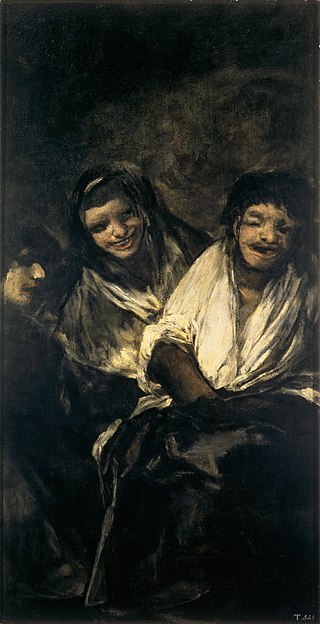
Man Mocked by Two Women or Women Laughing or or The Ministration are names given to a painting likely completed between 1820–1823 by the Spanish artist Francisco Goya.

Hispania is the national personification of Spain.
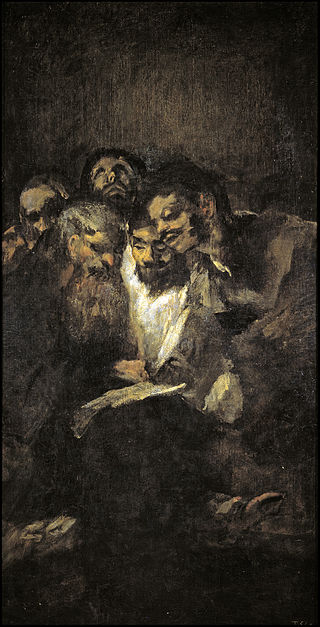
Men Reading or The Reading or Politicians are names given to a fresco painting likely completed between 1820–1823 by the Spanish artist Francisco Goya. It is one of Goya's 14 Black Paintings painted late in his life when, living alone in physical pain, spiritual torment and disillusionment with the political direction of Spain, he painted 14 bleak, agonised frescoes onto the walls of the Quinta del Sordo, the house he was living in alone outside Madrid.

Truth, Time and History is an oil-on-canvas painting by the Spanish artist Francisco de Goya. The painting is also known by the titles Spain, Time, and History and Allegory of the Constitution of 1812. It has been assigned dates ranging from 1797 to 1812, though it is most commonly dated between 1804 and 1808. It is currently in the collection of the Nationalmuseum in Stockholm.




















